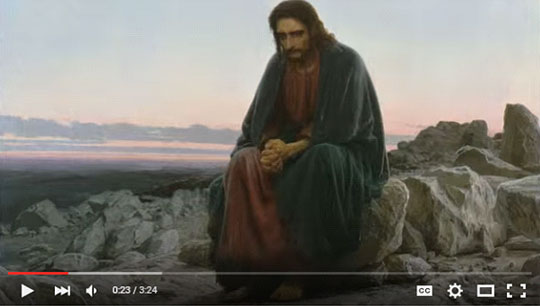The beauty of Lent offers a time for the Church to relive salvation history. By practicing the penitential disciplines of prayer, fasting, and almsgiving, many adults savor this transformative season. But how does an untrained teacher who meets only briefly with her wiggly second-grade faith formation class communicate the beauty and relevancy of Lent in language they can understand? The short answer: by acting out Christ’s desert experience in a way that highlights how fasting, prayer, and almsgiving give us strength as we walk with the Lord.
Since my class has been preparing to celebrate First Penance and Reconciliation, I began by making connections between Lent and our recent lessons on God’s mercy and forgiveness. These lessons about God’s love and forgiveness are fresh on their minds. The children know that God loves us and desires us to follow his commandments; they have been taught that God gave us free will, letting us decide for ourselves if we’ll follow him. They know that their conscience is yet another gift that guides their decisions. I also reinforced that we will encounter stumbling blocks as we walk with Jesus. We will face temptations, but God’s love will guide and sustain us.
We then read from the Bible the story of Jesus being led into the desert after his baptism and how he was tempted by the Devil. I explained that Lent is a season that lets us share in Jesus’ desert experience. That Jesus stayed true to his Father’s will while being tempted by the Devil gives us hope. I then invited the children to act out Jesus’ temptation. They chose among themselves kids to play the characters of Jesus, the Devil, and the angels that ministered to Jesus. The other children sat and watched closely as we discussed how Jesus’ walk was similar to—but different from—ours.
With a brief script based on the Bible, the play started and stopped periodically so that each element of Christ’s walk in the desert could be discussed and related to present-day events the children could understand. For example, when the Devil tempted Jesus to satisfy his hunger by turning stones into bread, we talked about times the students had to choose between doing something that was right even though it was hard and uncomfortable versus doing something that was quick and easy (like copying a friend’s homework instead of doing our own). Another example of comparing Jesus’ desert walk to the kids’ walk was when the Devil offered Jesus all the kingdoms of the world. All that would be required was to put God last and give the glory to someone or something else. One student offered up times that he and his parents have put a higher priority on sporting events on Sundays instead of making Mass the highest priority. The kids thought out the consequences of these choices, and they seemed amazed how their struggles were like Jesus’. I explained that with Jesus at our side and by God’s grace, we can overcome any temptation the Devil might throw in our way.
After this play, we took a look at a Lenten calendar handout (which I described as a countdown to Easter) that lists the days of Lent. Each day was numbered and appeared as a stepping stone that the children could color. We shared that there are times when the Holy Spirit leads us to be alone and quiet, just like Jesus sought out places of solitude and silence. I explained that these moments of quiet help help us “die to the world” and live only for Christ.
Finally, I handed out index cards that I called Promise Cards. I played calm and uplifting music while the children wrote down their Lenten commitments. Since time was tight, I wrote some suggestions of Lenten commitments on the whiteboard based on CCC 1438: I will say the Lord’s Prayer for someone who has hurt me; I will read the Gospel reading for that day instead of playing my video game; I will make a card for my sick aunt; etc. I told the children to take their cards home and review them each day during Lent. I also encouraged them to bring their cards to Easter Mass and leave them at the replica of Jesus’ tomb outside our church. This exercise reminds them that Lent is a season during which we walk through the desert to get to Easter, and that the penances we do—our prayer, fasting, and almsgiving—make the joy of Easter that much sweeter.






Be the first to comment